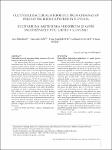Cultivable bacterial microbiota from choanae of free-living birds captured in Slovenia
Škaraban, Jure
Matjašič, Tjaša
Janžekovič, Franc
Wilharm, Gottfried
Trček, Janja
We have analysed the structure of cultivable choanal microbiota from free-living birds in relation to bird diet, its richness and the relative number of opportunistic bacteria acquired from the environment. For this purpose, we have taken choanal swabs from 25 free-living birds representing 13 different bird species captured in Slovenia. From the grown cultures, 98 bacterial colonies were isolated and their 16S rRNA genes sequenced. Most of the bacteria belonged to the phylum Actinobacteria (52 %), Proteobacteria (31 %), Firmicutes (15 %) and Bacteroidetes (4 %). Thirty-two percent of sampled birds were colonized by known human opportunists and 44 % of birds by at least one known plant pathogen. Hierarchical clustering of the analyzed microbiota grouped the birds according to their predominant diet. The richness of choanal microbiota from birds feeding mainly on insects was poorer compared to the birds feeding on diverse animal and plant material. The study has shown that the free-living birds carry an important reservoir of opportunistic human and plant pathogenic bacteria in their upper respiratory tract. To get a deeper insight into its composition, a bigger pool of birds will have to be analyzed in the future.
No license information

